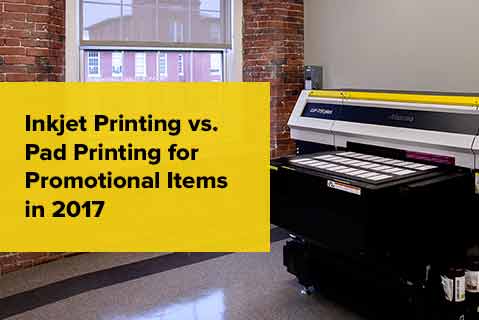Product Hub July 20, 2017
Inkjet Printing vs. Pad Printing for Promotional Items in 2017
When it comes to product decoration for most promotional items in 2017, you have three main options:
- Using a pad printer
- Using a direct, UV large format flatbed printer
- Printing on labels and applying them to the product
Since using labels is not cost-effective and has a lower perceived quality, pad and inkjet printing are your best options. But which is the right choice for decorating items like pens, lighters, golf accessories, plastics and other hard goods? We’ll break down each technique below.

Pad Printers
Pad printing is an analog process that uses a silicone pad that can form to the shape of any item, easily. The pad picks up ink from the printing plate (cliché) and stamps a logo or design onto the promotional item. Once pad printers are set up and running, they are actually a fast printing process – as long as your design is simple and only requires one color.
This method was designed for printing around small, curved surfaces, like golf balls or other objects with dimension. It is not intended for printing on larger objects.
As an analog process, pad printing may be suitable for large jobs with simple one or two color artworks. The pad process will only print one color at a time and a cliché must be made for each color (similar to a screen printing requiring a screen for each color). As you add more colors, you add significant time to the job. Also, when detailed print quality and/or four-color process printing is required, pad printing is not desirable. Even if an experienced pad operator can properly register each color, it will never compare to the photo-realistic print detail that inkjet printing can achieve.
An operator is also required to run the machine throughout the entire printing process. They will need to set up the inks, clichés and products. Since this is such a manual process, the likelihood of wasting ink is a lot higher than with other methods, which can affect your overall costs.
This technology also hasn’t changed much since its introduction in the 1970s, and it doesn’t show any signs of an update any time soon. However, this is still the go-to technique for those who need to apply metallic ink to their designs, or those looking to print large quantities of a simple image in one color.
Large Format Inkjet Printers
Inkjet printers have certainly come a long way in the past few years, especially when it comes to printing promotional items.
Specifically, print head technology has evolved to print on various dimensions, like on the Mimaki UJF-7151. This model features six print heads in a staggered configuration and can print on nearly any substrate, including plastics, metals, wood, leather and glass. Plus, unlike pad printers, inkjets like this Mimaki can print on large promotional items – up to 28” wide x 20” long and up to 6” thick.
Take a look at the Mimaki UJF-7151 in action in the video below.
Other options, like the Mimaki Kebab, offer 360-degree direct UV LED printing on cylindrical objects. The Kebab was developed exclusively for the promotional market and can print efficiently on items like tumblers, water bottles, candles and more.
Since orders are getting smaller and more frequent, saving time on setup costs and resources is key. Pad printing involves a lot of additional resources, setup and manual labor, which doesn’t make small batch orders worth the effort and upfront cost. The profitability with inkjet printing is unaffected by small orders, since there is very minimal setup and little operator responsibility involved. Moreover, high print quality is now the expected norm for most customers.
Customization is also a profitable possibility with inkjet printing, since the graphics are created digitally, as opposed to on a tangible cliché, and there is an endless opportunity for multi-color jobs with custom data or images. Where PAD printing would require the operator to mix colors and make/switch out clichés, inkjet printers take care of all that for you.
When inkjet printers were first introduced, the new technology was more expensive than the average pad printer. However, as inkjet printing becomes more popular, costs are going down. The inks may be more expensive than pad printers, however much less ink is used in the process and there is minimal waste. Also, no mixing is required by the operator, saving cost and labor in the long run.
If you were familiar with inkjet printing for promotional products 10 years ago, it’s definitely worth it to take another look at this technology. Inkjet printers are becoming more affordable, more reliable and faster than ever before. And while pad printing remains a stagnant technology, inkjets are constantly evolving to provide suppliers with the technology they need to create eye-catching products of the highest quality.

Product Hub
Find the latest in quality products, must-know trends and fresh ideas for upcoming end-buyer campaigns.
